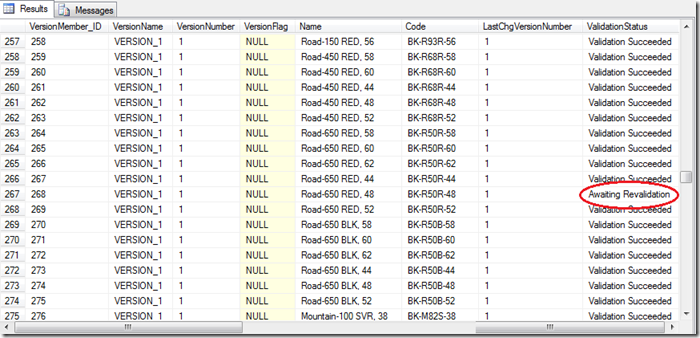Subscription Views are one of the ways to extract data from Master Data Services. Created via the ‘Data Integration’ section of the MDS Master Data Manager front end, they result in the creation of a physical SQL Server view in the underlying database.
All this you will probably know from the MSDN article. The purpose of this post, however, is to explain a few of the more subtle differences between the different types of subscription views that get created, and looking how they can be used to feed a data warehouse.
Derived Hierarchies
You can create a subscription view from a derived hierarchy, which will return all the levels from your hierarchy in a de-normalised form. If you choose the sample Product model, then you will see that one of the Derived Hierarchies that you can pick from is called Category. As your Product dimension in a data warehouse would include attributes such as Product Category and Sub Category, then on the surface this view looks to be ideal.
Unfortunately there is a slight issue with subscription views based on derived hierarchies. Users could have altered one of the members that exist within the hierarchy before the data warehouse nightly load has taken place. If the MDS validation of that member hasn’t occurred yet (which it doesn’t in some situations), then the member could potentially contain some incorrect attribute values that we don’t want to expose to the data warehouse.
For example, a user has edited a product, as shown below, but chosen a different Sub Category to that of its adjacent members:
As indicated by the yellow question mark above, the member is awaiting validation. However, when I run a select statement against my view that’s based on Derived Hierarchy Subscription view, then the member that is marked above will still appear in the view results. We would not want to load this change into the data warehouse, as until the business rules have been run, we dont know if the new Sub Category is valid in the context of the other attributes. For reference, the same behaviour exists for members that have explicitly failed validation.
Leaf Attributes
You can also create a subscription view by picking an entity, and then choosing the format of Leaf Attributes, as shown below:
In my case, I’ve set up a subscription view called ProductLeafAtributes, and when I run a select statement against this view in SQL Server, then I get the following results:
As with the subscription view that’s based on a Derived Hierarchy format, I still get all the members returned, but there’s also a column called Validation Status, that shows that one of the members is awaiting revalidation. Therefore, this column can be filtered on in the data warehouse load, just to take through the changes that have definitely passed validation.
Conclusion
Creating the subscription views based on entities, rather than Derived Hierarchies, exposes the validation status of a member, and is therefore the preferred subscription view format to use in this case. The one catch is that the Leaf Attributes format will not return attributes of any related entities, e.g. Product Category. It will return the Sub Category code, so therefore its necessary to join to separate Subscription Views for both Sub Category and Category in order to pick up the missing attributes.





Introduction to Data Wrangler in Microsoft Fabric
What is Data Wrangler? A key selling point of Microsoft Fabric is the Data Science
Jul
Autogen Power BI Model in Tabular Editor
In the realm of business intelligence, Power BI has emerged as a powerful tool for
Jul
Microsoft Healthcare Accelerator for Fabric
Microsoft released the Healthcare Data Solutions in Microsoft Fabric in Q1 2024. It was introduced
Jul
Unlock the Power of Colour: Make Your Power BI Reports Pop
Colour is a powerful visual tool that can enhance the appeal and readability of your
Jul
Python vs. PySpark: Navigating Data Analytics in Databricks – Part 2
Part 2: Exploring Advanced Functionalities in Databricks Welcome back to our Databricks journey! In this
May
GPT-4 with Vision vs Custom Vision in Anomaly Detection
Businesses today are generating data at an unprecedented rate. Automated processing of data is essential
May
Exploring DALL·E Capabilities
What is DALL·E? DALL·E is text-to-image generation system developed by OpenAI using deep learning methodologies.
May
Using Copilot Studio to Develop a HR Policy Bot
The next addition to Microsoft’s generative AI and large language model tools is Microsoft Copilot
Apr